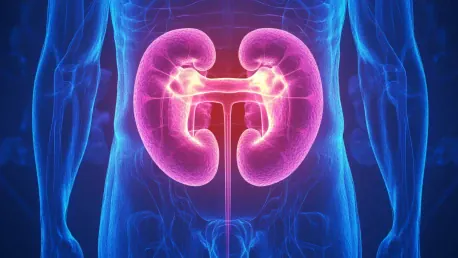Climate change is an urgent global issue with far-reaching impacts on human health. Among the many health concerns exacerbated by climate change, urological diseases and cancers are increasingly coming into focus. This article explores the intricate connections between climate change and the rising incidence of urological conditions, highlighting the need for awareness and action.
The Direct Impact of Rising Temperatures
Rising global temperatures are one of the most direct consequences of climate change, and they have a significant impact on urological health. Higher temperatures lead to increased rates of dehydration, which is a major risk factor for kidney stones. Dehydration causes the urine to become more concentrated, promoting the formation of stones. This is particularly concerning in regions experiencing prolonged heatwaves.
In addition to kidney stones, heat stress can exacerbate chronic kidney disease (CKD). Patients with CKD are more vulnerable to heat-related illnesses, and extreme temperatures can worsen their condition. The increased frequency and intensity of heatwaves pose a serious threat to individuals with pre-existing kidney conditions. It becomes increasingly important to manage hydration levels and monitor kidney function in such detrimental climatic scenarios.
Moreover, individuals without pre-existing conditions are also at risk. Prolonged exposure to heat without adequate hydration can lead to acute kidney injury (AKI), a sudden reduction in kidney function. This can happen to anyone experiencing significant dehydration and heat stress, emphasizing how rising temperatures directly impact urological health across various demographics. The surge in AKI cases during heatwaves highlights the urgent need for robust healthcare strategies to combat these direct effects.
Pollution and Urological Health
Climate change also contributes to increased pollution levels, which have a direct impact on urological health. Airborne pollutants, such as particulate matter and nitrogen dioxide, are linked to higher rates of bladder and kidney cancers. These pollutants can enter the body through inhalation and accumulate in the urinary tract, leading to cellular damage and cancer development.
Water pollution is another critical issue. Contaminated drinking water, often a result of industrial runoff and inadequate waste management, exposes individuals to harmful chemicals and pathogens. These contaminants can cause infections and increase the risk of urological cancers. For example, exposure to arsenic in drinking water is a well-documented risk factor for bladder cancer. The presence of nitrates in drinking water has also been linked to kidney disease, further stressing the interconnectedness of pollution and urological health.
The situation is exacerbated in communities with poor infrastructure and limited access to clean water. In areas where the quality of municipal water supplies is compromised, the risk of urological diseases spikes significantly. This highlights a glaring public health concern, where proactive measures such as stringent pollution control and efficient waste management are essential to mitigate these health risks. Without decisive action, pollution-induced urological conditions could become more prevalent, compounding the public health burden substantially.
Natural Disasters and Healthcare Disruptions
Natural disasters, which are becoming more frequent and severe due to climate change, have a profound impact on healthcare delivery. Hurricanes, floods, and wildfires can disrupt medical services, delaying critical treatments for urological cancers such as chemotherapy and radiation. These delays can lead to worse patient outcomes and increased mortality rates. In the aftermath of natural disasters, healthcare infrastructure often suffers extensive damage, compromising the ability to deliver timely and effective care.
The aftermath of natural disasters often results in compromised sanitation and water supply systems, increasing the risk of urological infections. In disaster-stricken areas, access to clean water and proper medical care becomes limited, exacerbating the spread of infections and complicating the management of chronic urological conditions. For example, floods can lead to the contamination of drinking water supplies with bacteria and other pathogens, increasing the incidence of urological infections.
Additionally, displaced populations following natural disasters are more susceptible to health issues. Evacuation and shelter conditions may not support proper hygiene and access to medical care, making individuals vulnerable to urological conditions. Temporary shelters often lack adequate facilities for managing chronic health conditions, which can exacerbate urological issues. These challenges underscore the need for resilient healthcare systems and emergency preparedness plans to address the growing threat posed by climate-related natural disasters.
Pathogens and Vector-Borne Diseases
Climate change alters the distribution of pathogens and vectors, leading to the spread of diseases that affect urological health. Rising temperatures and changing precipitation patterns create favorable conditions for the proliferation of mosquitoes and other vectors. This increases the incidence of vector-borne diseases such as schistosomiasis, which is linked to bladder cancer. Warmer and wetter climates provide the ideal environment for these vectors to thrive, posing a significant health risk.
Warmer climates also facilitate the growth of bacteria and fungi that cause urinary tract infections (UTIs). These infections can become more frequent and severe, particularly in vulnerable populations such as the elderly and those with compromised immune systems. The changing climate thus poses a significant threat to urological health through the spread of infectious diseases. For instance, increased humidity and stagnant water bodies can lead to higher rates of mosquito breeding, which in turn raises the risk of infections like malaria and dengue, both of which have urological implications.
Furthermore, the changing climate also impacts the distribution of diseases in previously unaffected regions. As temperatures rise and precipitation patterns shift, regions that were once inhospitable to certain pathogens now become viable habitats. This expansion of disease zones means that populations with little to no prior exposure—and hence lower immunity—are now at risk. The resulting increase in infectious diseases presents a new challenge for healthcare systems, emphasizing the urgent need for global coordination and response strategies to mitigate these emerging threats.
The Carbon Footprint of Urological Treatments
Urological healthcare is resource-intensive and contributes significantly to carbon emissions. Surgical procedures, diagnostic imaging, and the production of medical supplies all have a substantial environmental impact. The carbon footprint of these treatments is a growing concern, as the healthcare sector seeks to balance patient care with environmental sustainability. Unsustainable practices in medical facilities further exacerbate climate change, creating a feedback loop that worsens both healthcare and environmental outcomes.
To address this issue, there is a need for sustainable medical practices. Telemedicine, for example, can reduce the need for travel and lower carbon emissions. Additionally, innovations in eco-friendly surgical techniques and the use of renewable energy sources in healthcare facilities can help mitigate the environmental impact of urological treatments. Implementing energy-efficient technologies and reducing waste in medical facilities are crucial steps towards achieving a more sustainable healthcare system.
Moreover, healthcare providers can adopt practices that minimize the environmental impact without compromising patient care. For instance, using biodegradable materials for surgical supplies and reducing single-use plastics can significantly cut down on medical waste. Encouraging the development and use of more efficient medical devices that consume less energy also contributes to lowering the carbon footprint. Integrating these sustainable practices into everyday healthcare routines is essential for mitigating the long-term impacts of climate change on both human health and the environment.
Policy Interventions and Sustainable Practices
Addressing the intersection of climate change and urological health requires concerted efforts from policymakers, healthcare providers, and patients. Policy interventions are crucial to mitigate the health risks associated with climate change. This includes implementing early warning systems for heatwaves, improving pollution control measures, and ensuring access to clean water. Governments must prioritize climate-resilient infrastructure and enforce regulations that limit environmental degradation.
Healthcare providers can play a pivotal role by adopting sustainable practices. This includes reducing waste, optimizing resource use, and promoting telemedicine. Educating patients about the links between climate change and urological health is also essential. By raising awareness, individuals can take proactive steps to protect their health and advocate for environmental policies that reduce the impact of climate change. A well-informed public can push for changes that prioritize both health and sustainability.
Policy interventions should be supported by comprehensive research to inform decision-making. Investing in studies that explore the connections between climate change and urological diseases will provide the necessary evidence to guide policy development. Collaborative efforts between governments, non-profits, and academic institutions can lead to innovative solutions that address these health risks. Effective policies and sustainable practices combined with robust scientific research will enable societies to navigate the challenges posed by climate change and protect public health.
The Need for Research and Awareness
There is a significant gap in research and awareness regarding the links between climate change and urological diseases. More studies are needed to understand the full extent of these connections and to develop effective interventions. Healthcare professionals must be informed about the potential impacts of climate change on urological health to provide better care and guidance to their patients. Bridging this knowledge gap is crucial for developing effective strategies to address these health issues.
Public awareness campaigns can help bridge this gap by educating communities about the risks and encouraging preventive measures. Simple actions, such as staying hydrated during heatwaves and avoiding exposure to polluted water, can make a significant difference in reducing the incidence of urological diseases. Well-designed campaigns can motivate individuals to adopt healthier behaviors and advocate for environmental policies that mitigate climate change.
Moreover, integrating climate education into medical curricula can ensure that future healthcare providers are equipped to address the health impacts of climate change. This proactive approach will prepare the next generation of clinicians to recognize and treat urological diseases linked to environmental factors. Increased research funding and educational initiatives will amplify awareness and drive the collective action needed to mitigate the adverse effects of climate change on urological health.
Conclusion
Climate change presents a critical global challenge with profound effects on public health. Among the numerous health problems worsened by climate change, urological diseases and cancers are garnering increasing attention. The rise in temperatures, extreme weather events, and environmental pollutants linked to climate change have been shown to contribute to the prevalence of these conditions. For example, higher temperatures and heatwaves can lead to dehydration, which in turn increases the risk of kidney stones and urinary tract infections. Additionally, climate change can exacerbate exposures to harmful chemicals and toxins that may increase the risk of bladder and prostate cancers.
Rising sea levels and flooding can also lead to contamination of water supplies with bacteria, leading to more frequent urinary infections. Furthermore, the stress and mental health issues caused by climate-related disasters can impact overall health, potentially leading to the neglect of urological symptoms until they become severe.
The correlation between climate change and urological health underscores an urgent need for heightened awareness and proactive measures. Public health policies must consider the impact of our changing environment on urological health and aim to mitigate these effects through better resource management, pollution control, and public education. Addressing these health concerns is essential in a world where climate change continues to evolve, stressing the importance of global cooperation and comprehensive strategies to protect human health.









